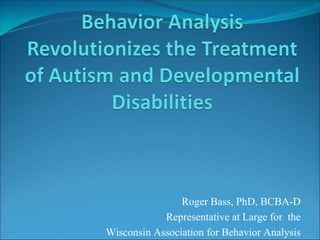
Rotary 8 3 2011
- 1. Roger Bass, PhD, BCBA-D Representative at Large for the Wisconsin Association for Behavior Analysis
- 3. Positive Approach to SIB What those data represent http://www.youtube.com/watch?v=WPGhg1asyG8
- 4. Imagine that’s your child… You’d want numerous proven procedures: Positive methods Mild negative methods used only when necessary For example, SIBIS http://www.youtube.com/watch?v=JCHtVLqJWpg&NR=1
- 5. Families are Transformed When SIBIS device is used—SIB reduces so other skills can be taught. This is Jamey’s mother: As the months passed, head hitting faded to a trickle. Jamey’s teacher wrote: “He’s gone from 32 hits last week to zero.” “The device is great,” wrote one of Jamey’s aides. “I spend more time teaching Jamey how to use a fork, than managing the SIB (self-injurious behavior).” Oh, happy, happy days!
- 6. A Graph of “O Happy Days” “Across all of the SIBIS- active sessions combined, Donna received 32 electric stimulations lasting a total of 2.6 seconds.”
- 7. Some Video Resources BAAM Video (90 seconds) BAAM Library (Variety of Videos) Richard Foxx—Harry from Research Press Freedom from restraints Hand Picking SIB
- 8. Wm Ahearn-NECC: Food Refusal
- 10. Within Reach: A better life for persons with severe developmental disabilities Life Skills Self-management Mobility (e.g., buses) Eating Toileting Speech and Langauge Job Skills Handling Emergencies Recreation
- 11. Analysis A Sampler Child abductions Bullying Addictions (all types) Smoking Academics College Teaching Autism/Asperger Syndrome Vocational Training Public Safety Anxiety (clinical issues) Medication (pharmacology) Criminal Justice Child abduction Public and Employee Safety Self-management Eating Disorders Gambling addiction Special/General Education Brain Injury Gymnastics & Sports Preschool Children/Education Self-injurious Behavior Creativity/Insight Speech/Language Problem Solving Following Rules Poison Prevention Self-Control Children’s Physical Activity Social Skills Parenting Violent Offenders
- 12. Within Reach: A Better Life for Persons with Autism Epidemic (1/110) High-vs-Low Functioning Cause: Unknown Early Identification Video (symptoms video--login) http://autismspeaks.player.abacast.com/asdvideoglossary-0.1/player/autismspeaks Treatment: Early Intensive Behavioral Interventions (EIBI) -30+ Hours/week Video-ABA (6:00) Effective Therapies
- 13. Some Autism Videos • General Introduction to ABA (3:37) • Descrete Trial Training (Amy & Dane) (1:43) • Nathan’s Matching (DTT) (9:35) • PECS 1: Cukes (22 seconds) • PECS-The Physical Exchange (3:01) • PECS-Communicative Partner (3:07) • Pivotal Response Training-General Overview (5:16) • Pivotal Response Training—Overselectivity (5:50) • Pivotal Response Training—Generalization/Maintenance (4:48)
- 14. Objects thrown per session 7/ 27 /2 0 5 10 15 20 25 30 00 7/ 29 0 /2 00 7/ 31 0 /2 00 8/ 0 2/ 20 8/ 00 4/ 20 00 8/ 6/ 20 00 8/ 8/ 2 8/ 000 10 /2 00 8/ 12 0 /2 8/ 000 14 /2 00 8/ 16 0 /2 00 baseline 8/ 18 0 /2 00 8/ 20 0 /2 00 8/ 22 0 /2 00 Brushing 8/ 24 0 /2 8/ 000 26 /2 00 8/ Interventions for Throwing 28 0 /2 00 8/ 30 0 /2 No Brushing 00 9/ 0 1/ 20 00 9/ 3/ 20 DRO 9/ 00 5/ 20 00 9/ 7/ 20 00 9/ 9/ ABA Technique 2 Debunking Fads: Shannon Kay’s Data on Brushing Parents as Researchers 9/ 000 11 /2 00 9/ 13 0 /2 9/ 000 15 /2 00 0
- 15. Researchers Debunking Fads: Shannon Kay’s Data on Brushing Problem: Aggression: hitting, kicking, or hair pulling inflicted upon adults & kids. Therapy: Brushing and joint compressions to help Evan “organize his experience” and would reduce his aggressive behavior. Interventions for Aggression 45 40 ggressions per 3 hour instructional session 35 30 25 ABA Technique 20 15 10 A 5 0 1 2 3 4 5 6 7 8 9 10 11 12 13 14 15 16 17 18 19 20 21 22 23 24 25 26 27 28 29 30 31 32 33 34 session number for each treatment condition baseline brushing and Joint Comp no brushing schedule w/time timer
- 16. Parents as Researchers Debunking Fads: Shannon Kay’s Data on Brushing Problem: Self-Injurious Behavior Therapy: Brushing and joint compression Interventions for Aggression 45 40 ggressions per 3 hour instructional session 35 30 25 ABA Technique 20 15 10 A 5 0 1 2 3 4 5 6 7 8 9 10 11 12 13 14 15 16 17 18 19 20 21 22 23 24 25 26 27 28 29 30 31 32 33 34 session number for each treatment condition baseline brushing and Joint Comp no brushing schedule w/time timer
- 17. Some Data Discussion This article reports the results of intensive behavioral treatment for young autistic children. O. Ivar Lovaas (1987). Behavioral Treatment and Normal Educational and Intellectual Functioning in Young Autistic Children. University of California, Los Angeles. 47% of the experimental group achieved normal intellectual and educational functioning in contrast to only 2% of the control group subjects.
- 18. IQ Changes Following ABA
- 19. Data: Early Intensive Behavior Interventions Proportions of children who moved from delayed to normal range on IQ (most also in regular classrooms without specialized services): Intensive ABA: 56/120 = 47% Typical special ed: 11/58 = 19% Intensive eclectic: 4/28 = 14% Several uncontrolled studies corroborate these findings Estimated savings from investment in early intensive ABA: $2 million+ per individual (Jacobson, Mulick, & Green, 1998)
- 20. Behavior Analysis: Gaining Recognition ABA recognized by: AAP ABAI APBA WI State Law Amy’s story Effective techniques aren’t enough Green’s data: Price of failure/Price of success Families/society/quality of life for children…
- 21. Lots of Good News Assessments and techniques work Research models improve our methods Credentialing system (BACB) Ethics controls State License State Insurance Mandate And….
- 23. Thank You Roger Bass, PhD, BCBA-D Ph: 262.853.1951 Email: rfb53074@aol.com Questions/Comments